Animals of Our Mountain Community
How About Those Woodpeckers?!?
By Lynn Stafford
With Liz and Bill Buchroeder, Terre Ashmore
Click here to read story
------------------------------------------------------
Pre-built Cabins for Birds
By Lynn Stafford
With Liz and Bill Buchroeder, Terre Ashmore
Click here to read story
------------------------------------------------------
Wintertime is Bird Feeder Time
By Lynn Stafford
With Liz and Bill Buchroeder, Terre Ashmore
Photos by Bill Buchroeder (BB), Darlene Freeman (DF), Mary McDevitt (MM), Charles Noble (CN) and Katy Penland (KP)
Watching our wild birds at residential bird feeding stations is great entertainment. However, because of our BEAR situation in PMC, it is inadvisable to have bird food outside during much of the year. The PMCPOA designates November 1 through April 1 as “bird feeder time.” Hopefully, the bears are at rest during that time period. The birds that visit us during the winter months are not here because we are here. They are present because this is their habitat, and has been since long before PMC existed. So, basically, the birds don’t need us. However, they will try to convince us that they need us desperately. Many of us have Steller’s jays that DEMAND that we keep those feeders full (Fig. 1).
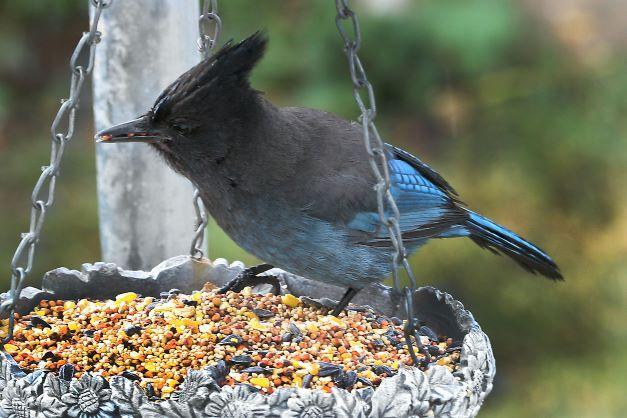
Fig. 1: Steller’s jay on mixed seed feeder (CN)
As far as I am concerned, the main reason for feeding birds is what it does for us. Many of us get great joy out of watching the juncos, sparrows, towhees, finches, chickadees, titmice, nuthatches, woodpeckers, hummingbirds and even the bossy jays fuss over the feeders and bird baths. The environmentalist in me thinks that people who enjoy nature are more apt to respect nature. Sitting in one’s living room on a snowy day, watching the feeder activity, is a very calming and mentally healthy occupation. It is a win-win situation, as long as the bears sleep.
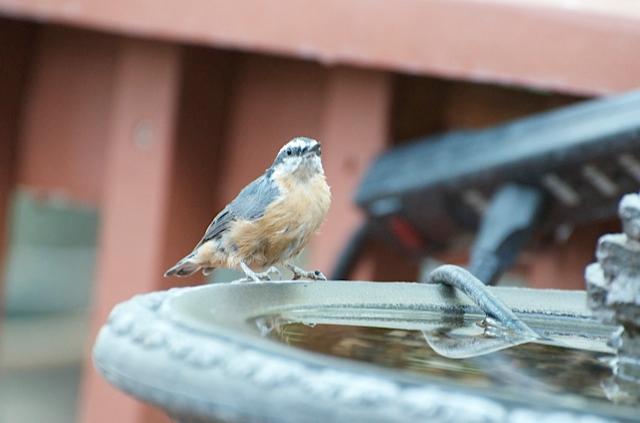
Fig. 2: Red-breasted nuthatch drinking (MM)
Different species of birds have different diets. Producers of commercial bird food know this. Pet stores and hardware stores (like Ace Hardware in Frazier Park) have many types of food and feeders for sale. I will discuss some of the common visitors to PMC’s feeding stations by the type of food and the method of eating. First, I wish to emphasize that there are important features of one’s yard beyond commercial food for wild bird comfort and safety. The planting and encouragement of bird-friendly plants, especially local natives, is essential. Also, small birds need to feel safe while they feed. Feeders should be placed near cover, such as bushes and trees. Water is important (Figs. 2 & 3). Some folks even bring out warm water to add to their frozen bird baths on frosty mornings (only do this on concrete, not porcelain, baths).
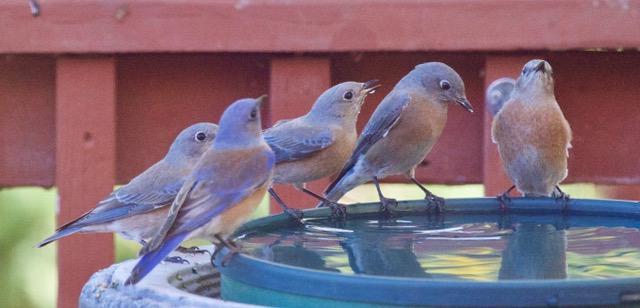
Fig. 3: Western bluebirds deciding whether to drink or bathe (MM)
Let’s start with the ground feeding birds. Juncos, sparrows and towhees prefer feeding on the ground, if they can dart out from nearby vegetation to feed on scattered seed. If the seed contains sunflower seeds, corn or peanuts, it will attract those pesky jays. Millet seed is the best for the little ones. Some of our wintering ground feeders include the dark-eyed (Oregon) juncos (Fig. 4), white-crowned, golden-crowned and fox sparrows, California and spotted towhees and, occasionally, a secretive California thrasher. And, of course, the quail will grace you with their presence. The common California quail is occasionally joined by the elusive mountain quail.
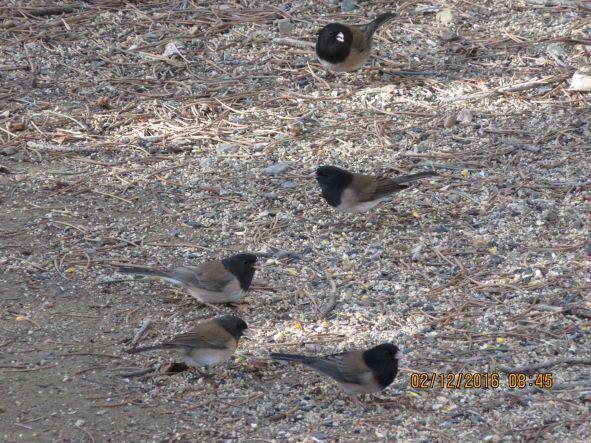
Fig. 4: Dark-eyed juncos feeding on seed spread on ground (BB)
Feeders placed higher up, such as on deck rails, may attract some of the above species, but also others, including finches, chickadees (Fig. 5), titmice (Fig. 6), nuthatches, acorn woodpeckers, and those jays, including both Steller’s and California scrub-jay. The uncommon red crossbill (Fig. 7) even shows up occasionally.
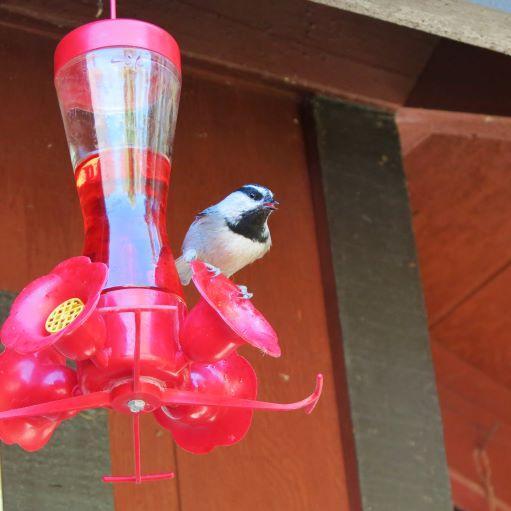
Fig. 5: Mountain chickadee on nectar feeder (DF)
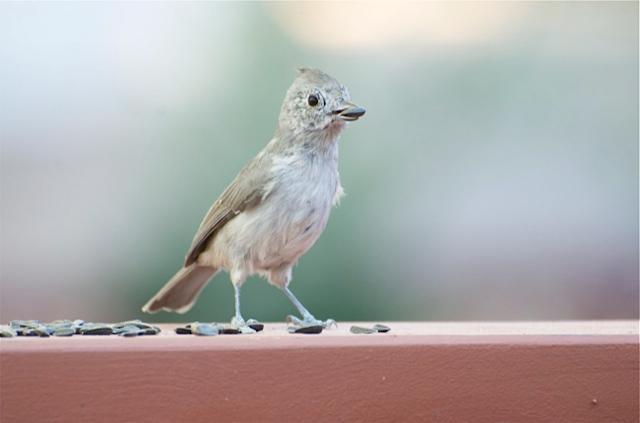
Fig. 6: Oak titmouse eating seed spread on deck rail ((MM)
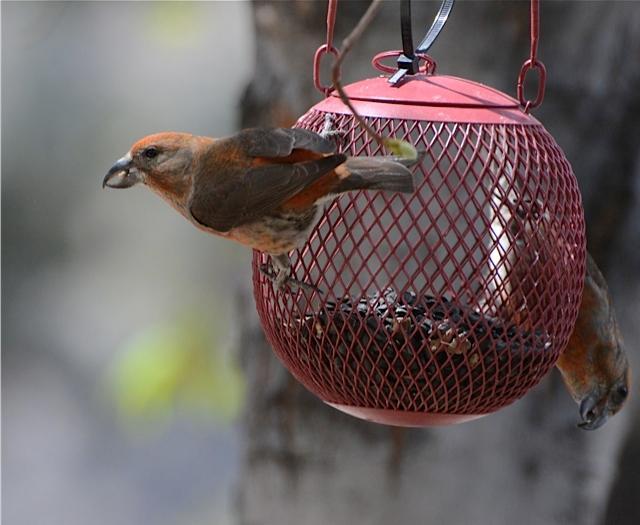
Fig. 7: Red crossbill at a sunflower feeder (MM)
There are several specialty foods. Nectar feeders bring any Anna’s hummingbirds that remain up here in the winter. There is a special (and expensive) tiny seed called nyjer thistle seed. There are several types of thistle feeders, including socks, tubes and mesh. Various finches will come eagerly. Some of our more common species are lesser goldfinch (Fig. 8), pine siskin and house finch.
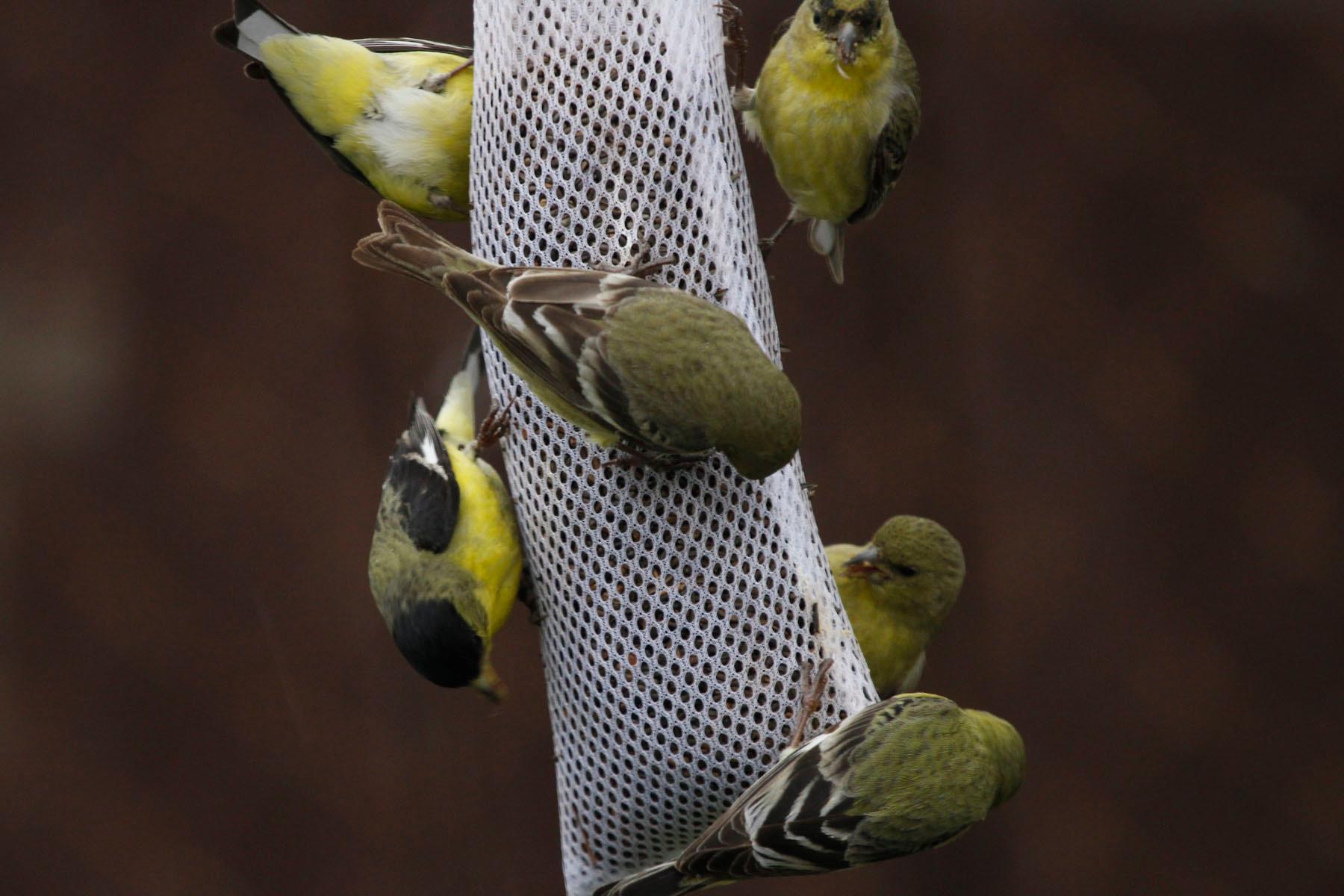
Fig. 8: Lesser goldfinch on nyjer thistle tube feeder (CN)
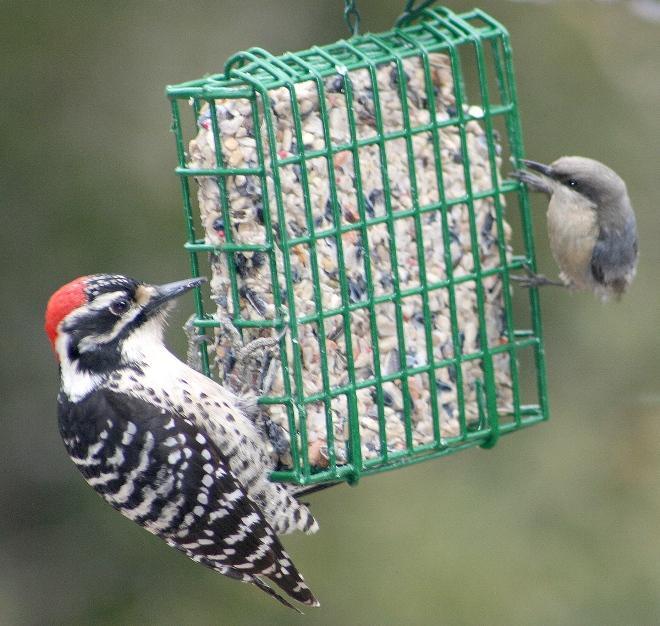
Fig. 9: Nuttall’s woodpecker and pygmy nuthatch on suet cage (KP)
Another attractant is suet. Blocks of suet are usually kept in suet cages. Winter is the time for suet feeding. The summer sun won’t melt the fat, and bears won’t smell the ‘goodies.’ Woodpeckers (Fig. 9), nuthatches, titmice and chickadees are particularly drawn to suet. Slices of fruit can be placed on branches, although that is more important in the summer, when the orioles arrive. If one really wants to get serious, meal worms from a pet store will bring out the bluebirds and other insect eaters. Sometimes, just scattering a few seeds on the deck railing will bring in feathered friends, such as pine siskin (Fig. 10).
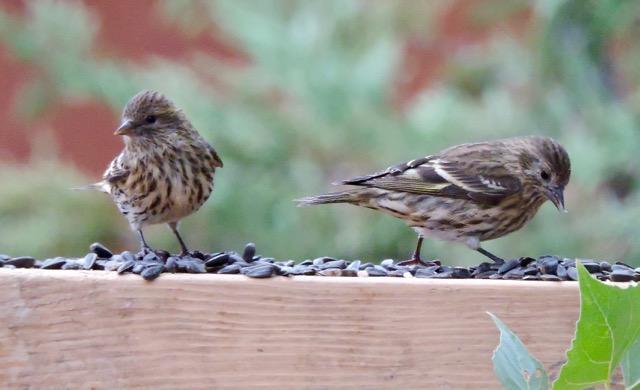
Fig. 10: Pine siskins enjoying seed on deck rail (MM)
There are a few caveats I need to mention, besides avoiding hungry bears. We call them bird feeding stations; certain hawks call them hawk feeding stations. Our local Cooper’s and sharp-shinned hawks, both eaters of small birds, are aware of each and every PMC bird feeding station, I am sure (Fig. 11). This is the main reason why cover is so important. Another problem concerns windows. Birds do hit and, sometimes, die from window collisions. Keeping feeding stations away from windows can reduce this threat. One study showed that the area between three feet and 30 feet from the window is the danger zone. I do not know if this conclusion has been verified. Another caution is preventing the transmission of avian disease. Too many feeders all together tend to attract large numbers of birds, which increases the spread of disease. Also, feeders, including hummingbird feeders, need to be kept clean.
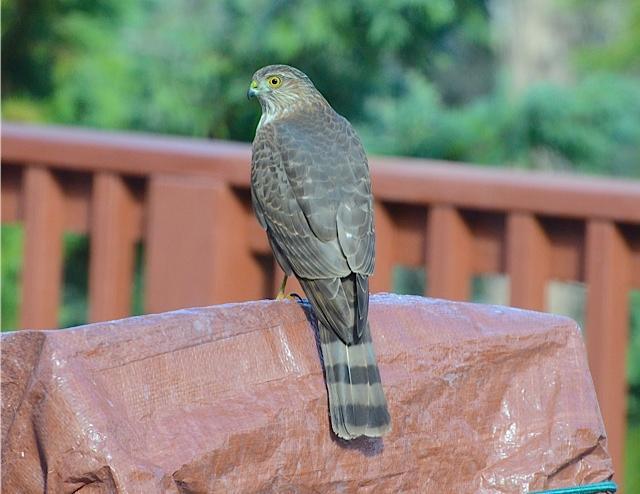
Fig. 11: Cooper’s hawk on rail watching the little birds (MM)
There are two distinct attitudes towards our gray tree squirrels. One, “They deserve to eat as well as the birdies.” Two, “I did not put out seed for the &*#@ squirrels.” If you really care about the issue, there are sites online with squirrel detractors. However, I am not sure they will work. Fortunately, our ground squirrels are cozy in their underground dens during the winter. And chipmunks are too cute to bother about. Also, chipmunks don’t chase other creatures away, and don’t eat very much. So, the gray tree squirrels are the main rodent issue.
I have mentioned some of the local birds that come to feeders, but not all, by any means. If you encounter a bird that you do not recognize, please feel free to contact me, especially with photographs, at [email protected]. I will respond to your email. Enjoy the winter, and its feathered visitors.
------------------------------------------------------
The Night World
By Lynn Stafford with Liz and Bill Buchroeder
All photos were taken in Pine Mountain Club
Humans are primarily daytime creatures. In modern times, through the development of candles, lanterns and then electricity, we have moved daytime indoors, thus extending our daily activity periods. But still, we tend to turn off lights to sleep. Dark time is sleep time. Here in Dark Skies-aware PMC, there are no streetlights. Residential outdoor lights are few. Someone viewing our village from a nearby mountain ridge late at night would see a few bright points of light letting them know there was a human settlement. There would be little activity, few vehicle lights. This is one of the important differences between us and the cities below.
Buck
As we humans slumber or read late into the evening, a world comes alive outside in the woods, along trails, down creek beds and between houses. There are many wild animals that prefer dawn and dusk and even midnight to conduct their daily affairs. Owls, bats and moths are among the aerial denizens. Owls seek night-active rodents and other creatures. Bats are using sonar to locate and capture night-flying insects. Moths use scent and perception of white color to find night-blooming flowers.
Fawn
On the ground, moving out of wood piles, coming up out of burrows, passing down from forest and brush dens come the night mammals. This article will focus on some of these elusive creatures that are right here in PMC. They were here before PMC was built in the early 1970s. They are natives; they don’t need people and most avoid people, although some have found people useful. White-footed mice and wood rats love to build nests in our structures. Bats often find daytime shelter in our buildings during the summer months when they are present. And, of course, deer enjoy some of our planted morsels.
Gray Fox
Then, there are the bears! Bears, like humans, are omnivores. They will eat almost anything. Their sense of smell is outstanding. Some hand lotion left in a car; a sack of dog food on the deck; even a window left open so that the kitchen smells can pass through the screen will entice a hungry bear. And bears are always hungry. They store up fat for the lean times of winter. Unfortunately, some bears have been legally shot by authorities in PMC because they have become dangerous. But all that is due to carelessness on the part of us humans.
Mama Bear and Cubs
There are several enterprising photographers up here who place motion cameras out to capture the wildlife. Included are several photos taken right here in PMC; some in the daytime, some at night. One captured shot shows a sow bear guiding her two cubs on a food hunt. The older fawn deer has yet to grow into its ears. A buck in the fall knows there is safety from hunters in the greenbelts of PMC. A long-tailed gray fox uses its nose to search for small rodents. For stealth and secrecy, there are the cats. A bobcat is at high alert with short tail curled up, ears up and body poised. Finally, a secretive mountain lion passes silently between homes searching for the deer.
Mountain Lion
It is always important to remember that we humans are the newcomers here. Our mountain paradise has been home to the wild animals for thousands of years. Most of them are not adapted to deal with fast vehicles and bright headlights at night. Driving slowly and carefully is not only important for feeling the tranquility of our forests, but essential for the safety of the nightlife that is still trying to figure us out.
Bobcat
------------------------------------------------------
A Welcome Return of Spring Birds
By Lynn Stafford
Photos by Ken Baker, Bill Buchroeder, Randy Cushman, Mary McDevitt, Charles Noble, Maryann Ryan and David Schindler
In Pine Mountain Club, the month of May means lilac blossoms, longer and warmer days, greenery, butterflies and birds. Many of our wild birds are here year-round, but come spring and summer, they are more obvious and louder, and other migrants show up. It is time to establish guarded territories, pair up, build or repair nests and begin the family. Baby birds need a lot of protein. When the plant life rejuvenates, the insects emerge. These insects are like protein bars for the growing avian youngsters.
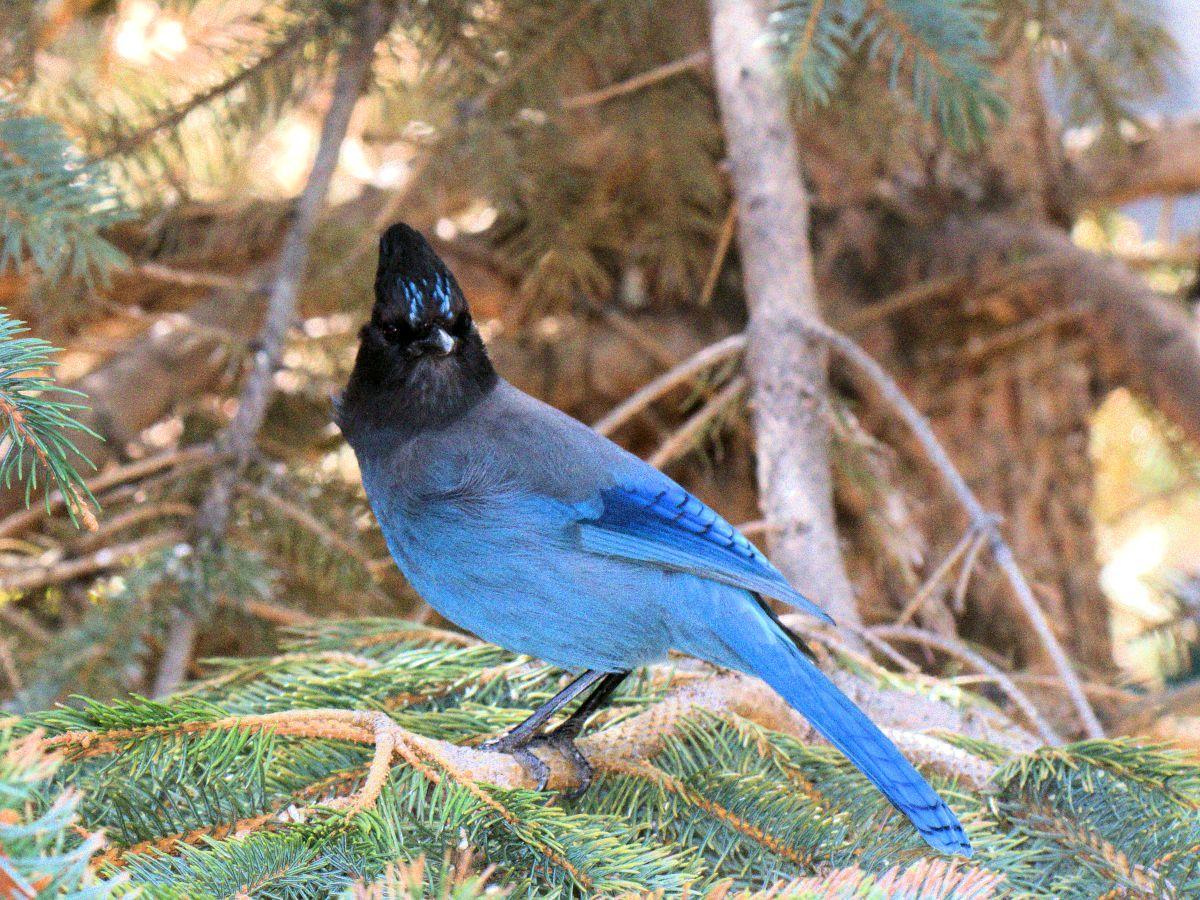
Fig. 1, Stellar's Jay

Fig. 2, Two baby Steller’s jays just out of the nest
One of our most well-known mountain forest birds is the Steller’s Jay (Fig. 1). It is all the parents can do to provide enough food for their ravenous, fast-growing, screaming-for-more-eats brood (Fig. 2). Our other local jay is the California scrub-jay (Fig. 3), more common in brushy areas, often around oaks and pinyon pine. It is not as loud as the Steller’s Jay, but equally skillful at harvesting pinyon pine nuts and acorns in the fall, and hiding them for later groceries.
Fig. 3, California Scrub-Jay
I will mention two of our small woodland birds. These are the white-breasted nuthatch and the mountain chickadee. Both of these little busybodies love trees and build nests in woodpecker holes (or nest boxes). And both species eat insects and other small invertebrates. But, in lifestyle, they could hardly be more different.
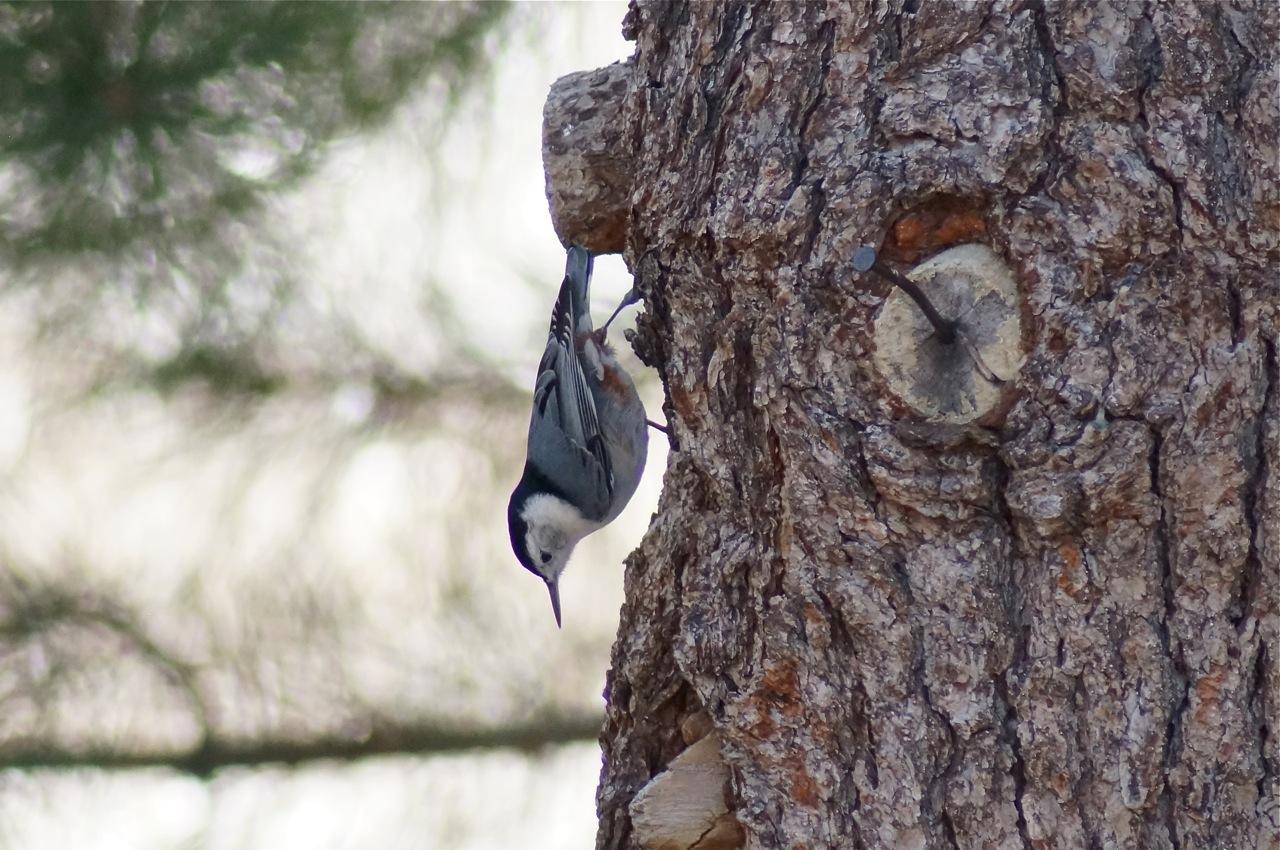
Fig. 4, White-breasted nuthatch descending a pinyon pine
The nuthatch (Fig. 4) views the world differently than do humans and most other birds. Their world is upside down; or, to them, our world is upside down! For the nuthatch, foraging for food means flying to the top of a tree trunk, then working its way straight down the trunk, gleaning insects and such from underneath the flakes of bark. Meanwhile, often in the same tree, way up on top of the smallest twigs, the chickadee is deftly skipping from one clump of needles to another, being very acrobatic and in constant nervous motion (Fig. 5). These two tree-dwellers live close together, but rarely interfere with each other’s lives.
Fig. 5, Mountain Chickadee in a pinyon pine
Moving to the open areas between the woods, such as meadows, fields and our golf course, we find two common residents who are related, but whose lives are different. These are the western bluebird and American robin, both members of the thrush family. Bluebirds bring to mind bird nesting boxes. Many local residents have successfully reared a clutch of baby bluebirds in their nest boxes. Naturally, bluebirds are hole-nesters, preferring old woodpecker holes. However, they have a problem in and around our community. We humans are required to eliminate the dead trees and dead branches that might have old woodpecker holes in, order to achieve fire safety. Other than that fact, we have excellent bluebird habitat. A nice meadow or vacant lot with a tree or fence to perch on is perfect.
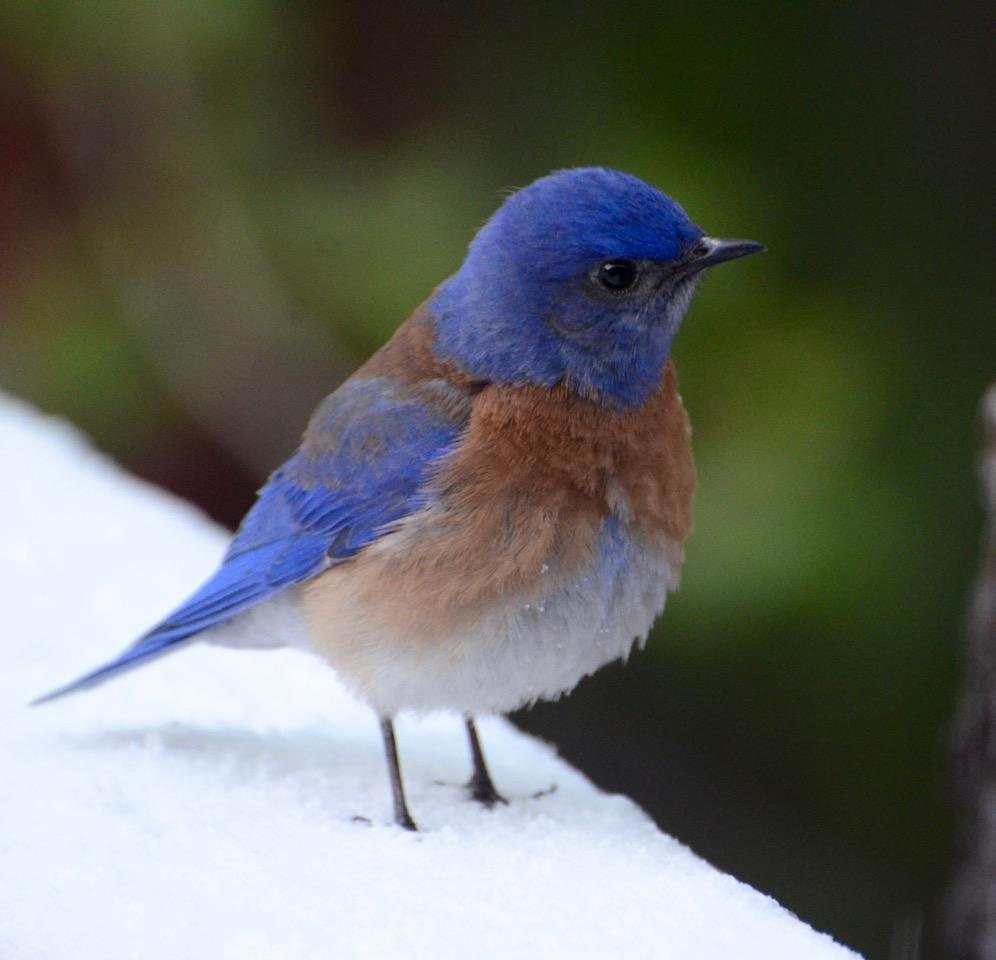
Fig. 6. Western Bluebird male on snow-covered deck rail
(Fig. 6) shows a bright male on a deck railing in the snow. Bluebirds like to sally out from a perch and snag an unfortunate insect. Very little insecticide is used in PMC, so there are plenty of insects. Placing a bluebird nest box on one’s property makes good sense in PMC, because we have everything a pair of bluebirds would want except enough tree holes. If one is interested, one can find the proper dimensions for a box online.

Fig. 7, American Robin
Our second thrush relative is the well-known American robin. It is easy to associate robins with green grass and earthworms (Fig. 7). Worms are one of their favorites foods. Robins have been eliminated in some areas by overuse of insecticides and herbicides, but not here in PMC. The sight of a robin on a green lawn is a sign that it is a healthy lawn, free of toxins. By the way, the bird mentioned in many English tales and in Shakespeare as a red-breasted robin is not the same bird. Early settlers to America got confused. Our robin has an orange breast.

Fig. 8, Black-headed Grosbeak male
Spring is also a time for immigrants from the south. I am going to discuss two of the most common and flashiest summer visitors. First, we have the black-headed grosbeak (Fig. 8). This big-headed and huge-beaked relative of sparrows has wintered in Mexican woodlands. It escapes intense competition for nesting opportunities in the tropics and sub-tropics by coming north. This is a seed-eater. Both parents take turns warming the eggs, the female being the less obvious with her striped coloration (Fig. 9). The male has a powerful voice and often sings from the nest, which is unusual for male birds.
Fig. 9, Black-headed Grosbeak female
Then, we have the Bullock’s oriole (Fig. 10). This is a neon-light beauty that also moves up north from Mexico for the summer, enjoying less competition and plenty of food. Orioles are unusual in that they have to build their nest in a hole, however they do not need a hole in a tree. How is that possible? They weave an elaborate sock out of plant fiber, attaching it to a branch. It has a hole in the side for entrance. They don’t compete with the other Mexican visitor, the grosbeak, for food. They prefer insects, fruit and nectar. Many folks have put out hummingbird feeders. Orioles consider them oriole feeders.
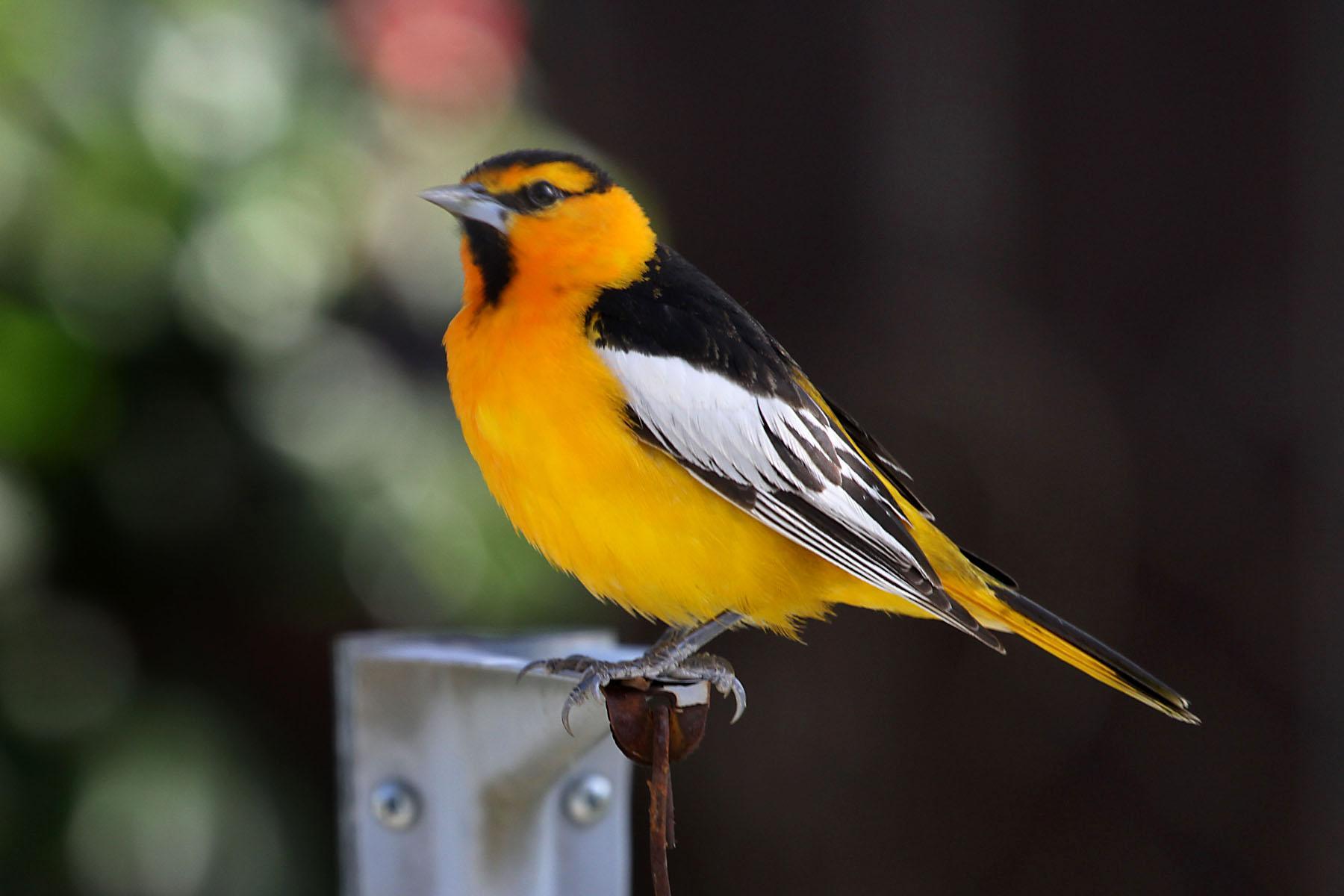
Fig. 10, Bullock’s Oriole male
Before we say goodnight, let’s listen to the night talk. HOO HOOHOO hoo hoo. We have several owl species in and around PMC. The most likely to be heard is the great horned owl. This is an impressive large predator and fierce parent (Fig. 11). The call often can be heard shortly before dawn. A nice cup of hot coffee on one’s deck makes the experience very pleasant. The call is a deep hoot. The male’s song is lower in pitch than the female’s, even though she is bigger than he is. If one hears a blending of two calls in syncopation, one lower and one higher, especially in late winter, this is the renewal of vows between a pair, and a commitment to raising a brood in the coming spring and summer.
Enjoy the spring; enjoy the renewal of life.
Fig. 11, A watchful Great Horned Owl mother near her babies
------------------------------------------------------
Special Winter Visitors to Fern’s Lake
By Lynn Stafford with Liz & Bill Buchroeder
Photos by Liz and Bill Buchroeder
Our Fern’s Lake, off Edgewood Way in PMC, is special for many reasons. It serves as a water pick-up for helicopters involved in fighting local wildfires. It is a reservoir serving the golf course and the storage of water from the Woodland Creek diversion. It is a recreation park for residents and visitors. It offers catch-and-release fishing. In these challenging COVID times, it is a beautiful spot of nature where one can rejuvenate one’s spirit. A parking area with a porta-potty welcomes visitors between dawn and dusk. Signs help visitors to follow rules of etiquette and safety.
Fern’s Lake was created as part of the development of Pine Mountain Club. It is the lowest of three golf course ponds. It was built on part of the Mil Potreros Wetlands, which originally extended from the Clubhouse down to San Emigdio Canyon. The wetlands now start below Fern’s Lake. The lake is named for an early resident and next-door neighbor who volunteered to help maintain the quality of the water by periodically clearing out large quantities of algae.
The Lake attracts many wildlife creatures. Several mammals come down at night when people are gone to drink and prowl around. Various birds can be found on the lake and in surrounding vegetation.
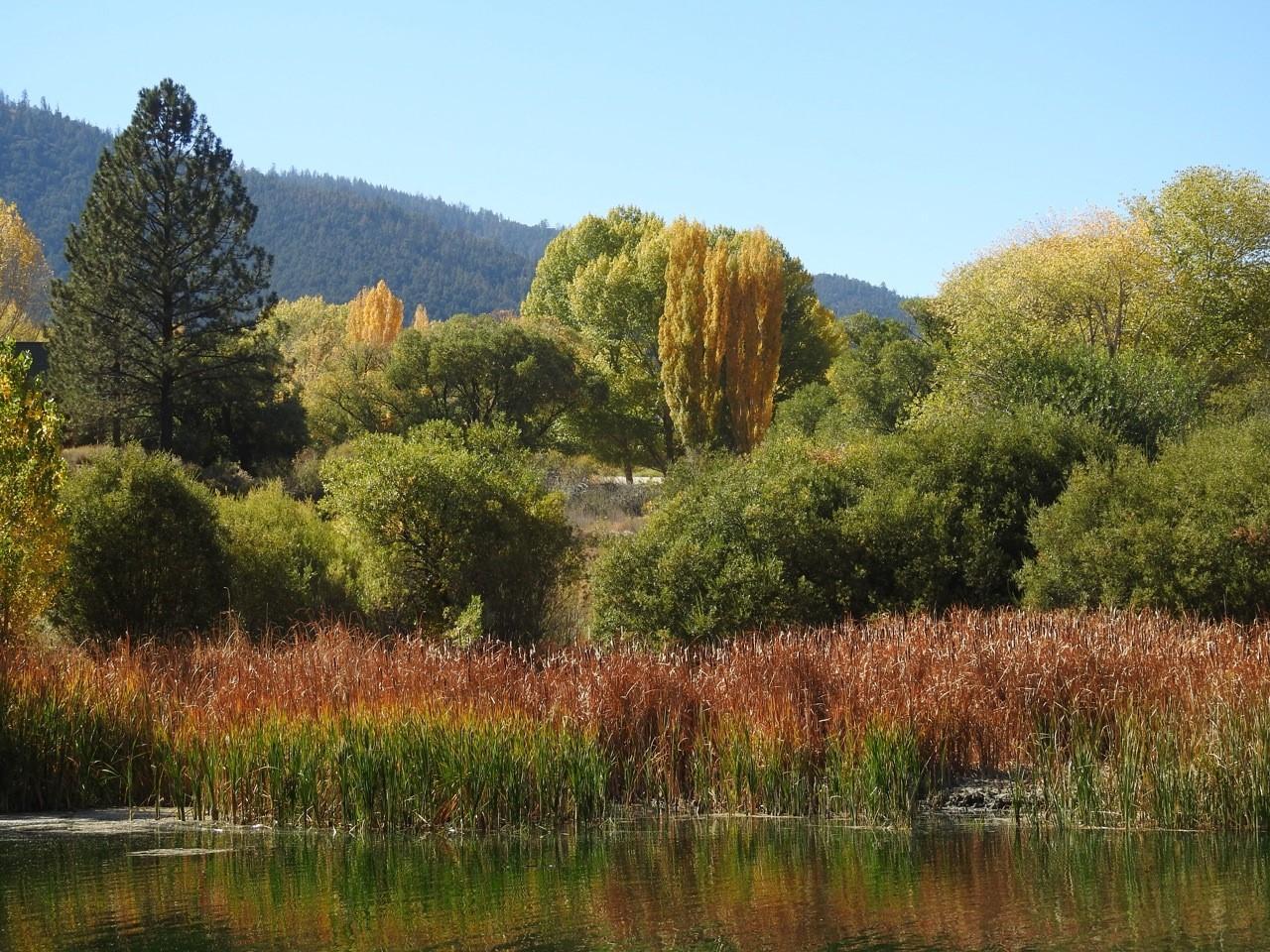
Fern's Lake
This article is about one very special winter duck visitor -- the ring-necked duck. This black and white diving duck nests in inland wetlands of the northern States and Canada. It then migrates south for the winter. For some reason unknown to us, a flock of 50 to 200 of these ducks have been wintering at Fern’s Lake each year from about October through March. There are very few locations in California where this many individuals of this species congregate in winter. I have no idea how ducks’ GPS systems work, but they seem to understand the location and quality of small ponds as well as some human travelers recognize the presence of their favorite fast-food outlet.
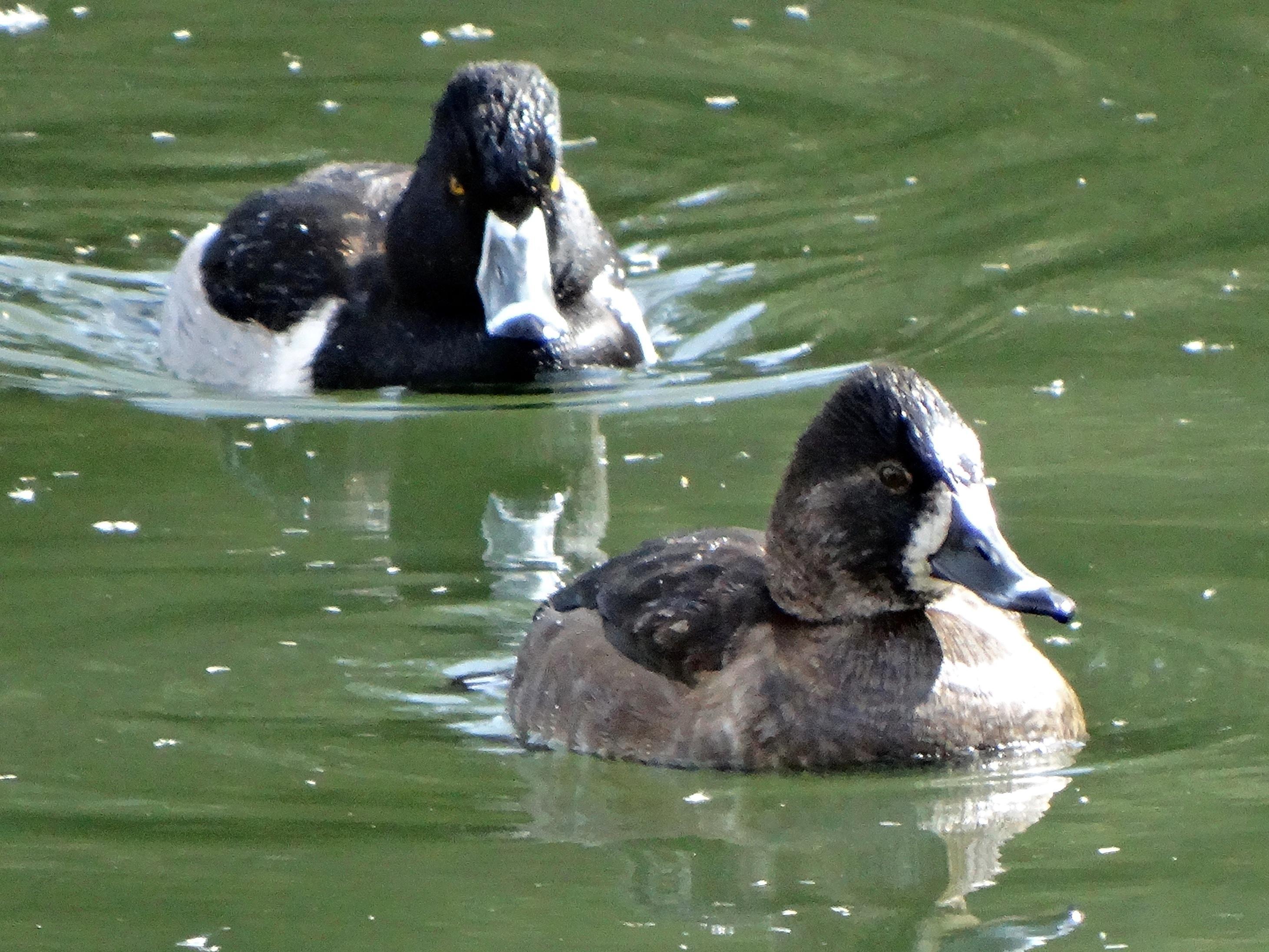
Ring-necked ducks
Two years ago, the lake was dredged and cleared of cattails to enhance the access of helicopters. We were concerned that this disruption of the ecosystem might discourage the ring-necked ducks. Last winter, we saw only a few visiting for short periods of time. However, they are BACK! Obviously, this pond is healthy for wildlife. Golf course maintenance minimizes pesticide applications. Already this winter, wildlife photographers Liz and Bill Buchroeder have documented at least 122 birds.
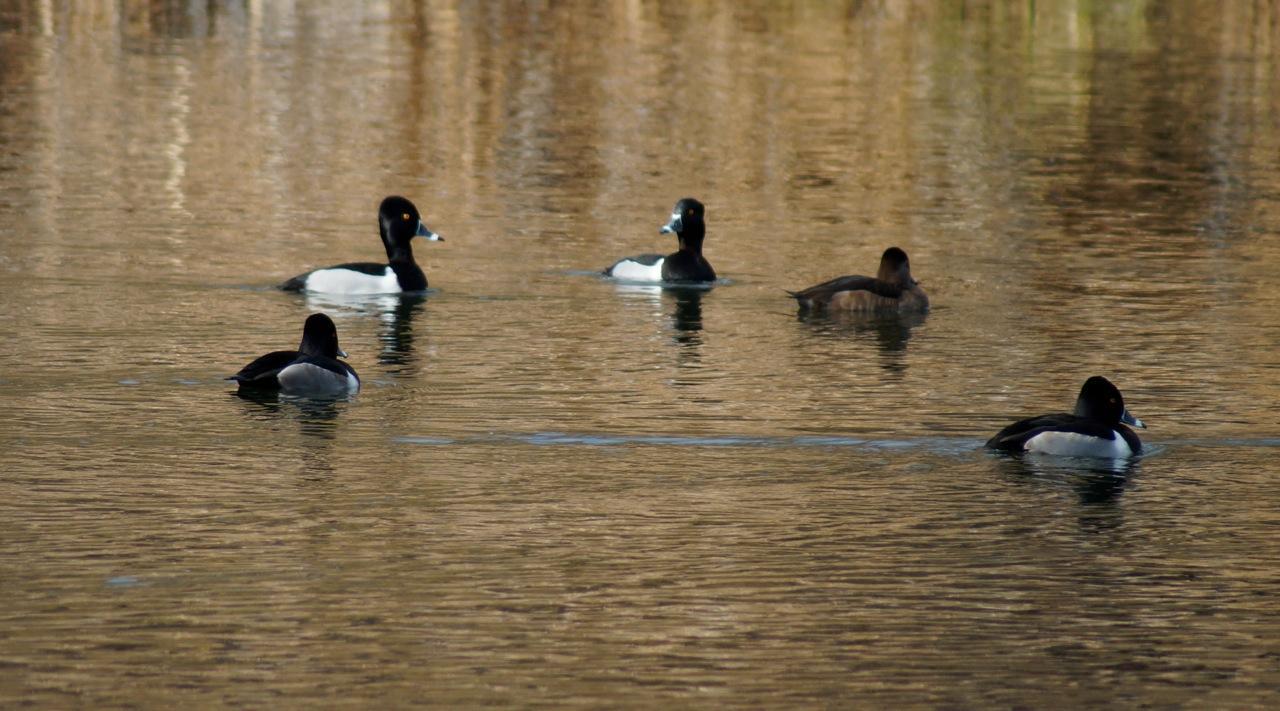
Photo of ring-necked ducks from furthur away
The ring-necks are shallow divers, feeding on both animal and vegetation food. They are related to scaups, redheads and canvasbacks. Being a ‘Harvest Species,’ meaning they can be legally hunted by permit, they are quite leery of humans. If someone approaches the lake’s edge, the flock will slowly work its way across the lake to the other side. Of course, neither hunting nor shooting is permitted ever in PMC.
Every winter in mid-February, birders throughout the world conduct a bird censuses known as The Great Backyard Bird Count. One-quarter of a million separate counts representing 7,000 species on all continents were tallied last year. Liz Buchroeder records birds at the three PMC golf course ponds. Her counts of ring-necked ducks at Fern’s Lake are among the highest of any count in California. No, we don’t understand the attraction, but we really appreciate their presence.
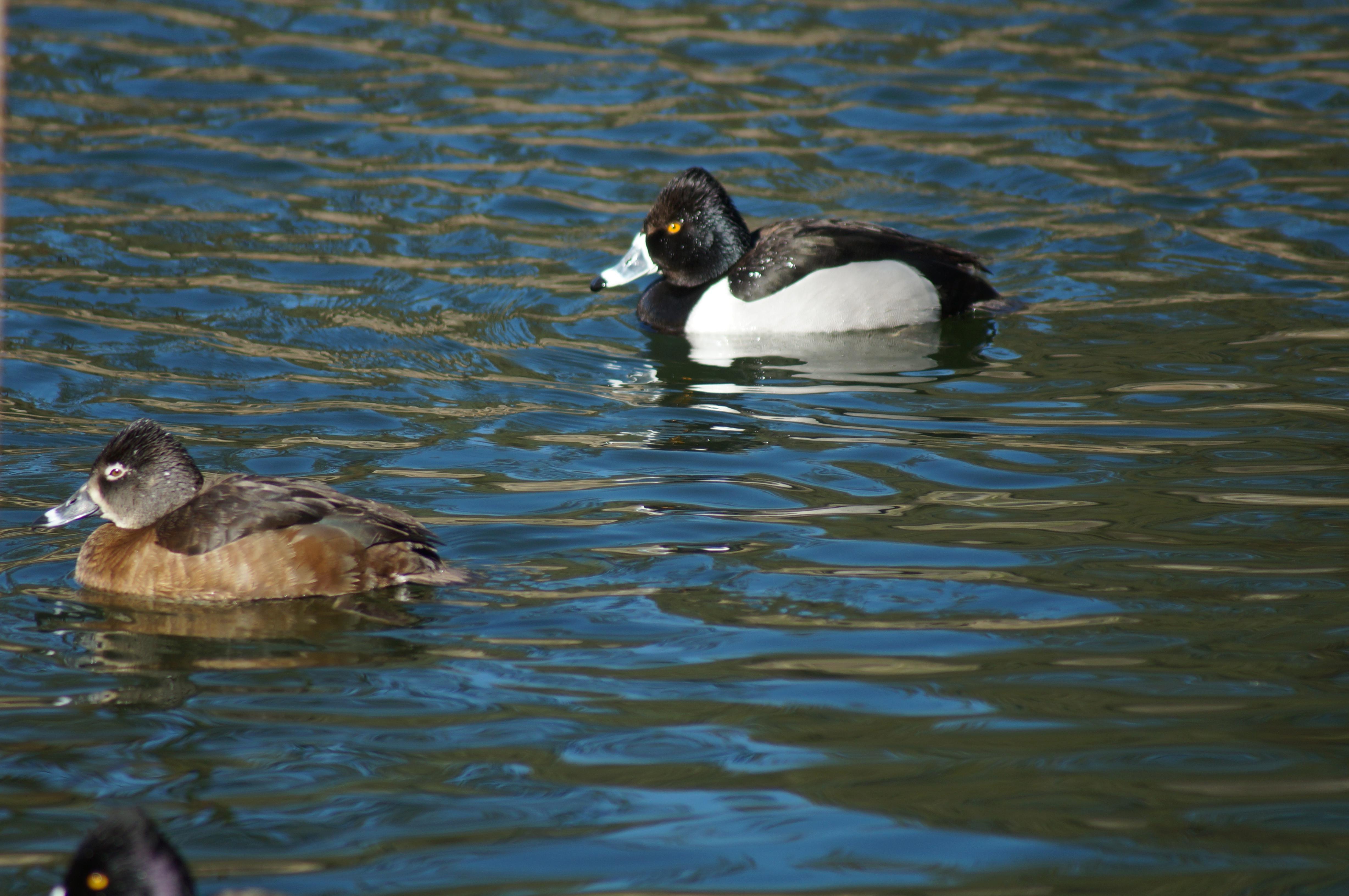
More ring-necked ducks
The males have a characteristic black-and-white saddleback appearance, while the females are more subdued, but highly attractive. An interesting, and slightly frustrating, tidbit of information involves the name. These birds have a noticeable ring around the bill, so why is their name ring-necked duck? Taxonomists who name newly discovered animals often work with dead specimens in laboratories. It turns out that if one parts the neck feathers, there appears a thin line of cinnamon-colored under-feathers. This feature is highly unusual, and so earned the bird its name. Interesting history, but not helpful for field identification.
Do visit our charming little lake! Whether on a cold, dark winter day with floating ice; a fresh spring morning with the willows popping out in catkins and leaves; during a summer’s evening with swallows working the insects over the water; or on a fall afternoon with bright yellow cottonwood leaves floating through the brisk air – this spot is a treasure for relaxation and renewal.
------------------------------------------------------
The ACORN WOODPECKER
By Lynn Stafford
Binomial: Melanerpes formicivorus
Seasonal Status: Permanent Resident
Range in the vicinity of PMC: Entire watershed, except for highest peaks. It has been recorded east of Chula Vista Campground at over 7,800 feet elevation. This may be one of the highest records of elevation in California for this species.
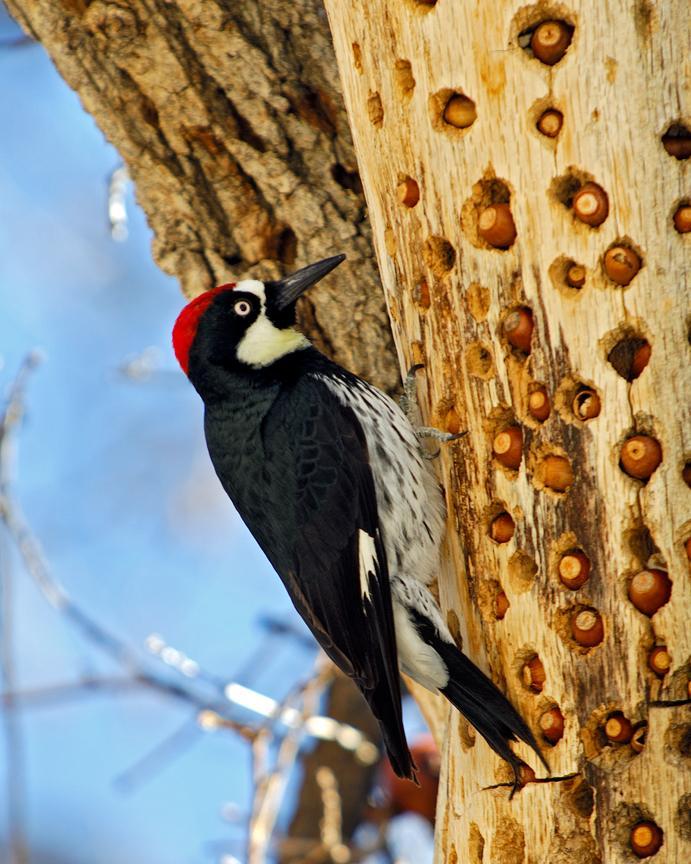
Habitat: Requires oaks. In the vicinity of PMC, canyon live oak is probably the species’ principal provider of acorns. Large trees of other species and utility poles are frequently used for granaries and nest holes. Houses are also used, which can be a touchy subject for the human residents.
Identification: Very distinctive in appearance. No other woodpecker has the classic ‘clown’ face pattern. Sexes are similar, but can be identified by a minor difference in head pattern. The female has a smaller amount of red on the head, which is separated from the white above the bill by a narrow band of black.
Feeding: Dependent upon oaks, but can be a frequent visitor to feeders. They love suet. They will tend to dominate all other species at your feeders except squirrels.
Nesting: They are not attracted to nest boxes. They are a very unusual woodpecker in their behavior and lifestyle. They are communal, having groups between two and 16 in number. Large families will have divided work tasks, and may include some younger, non-breeding adults. They establish granaries in tree boles, utility poles and even houses. They build holes in trees and poles for nests, and defend their territory.
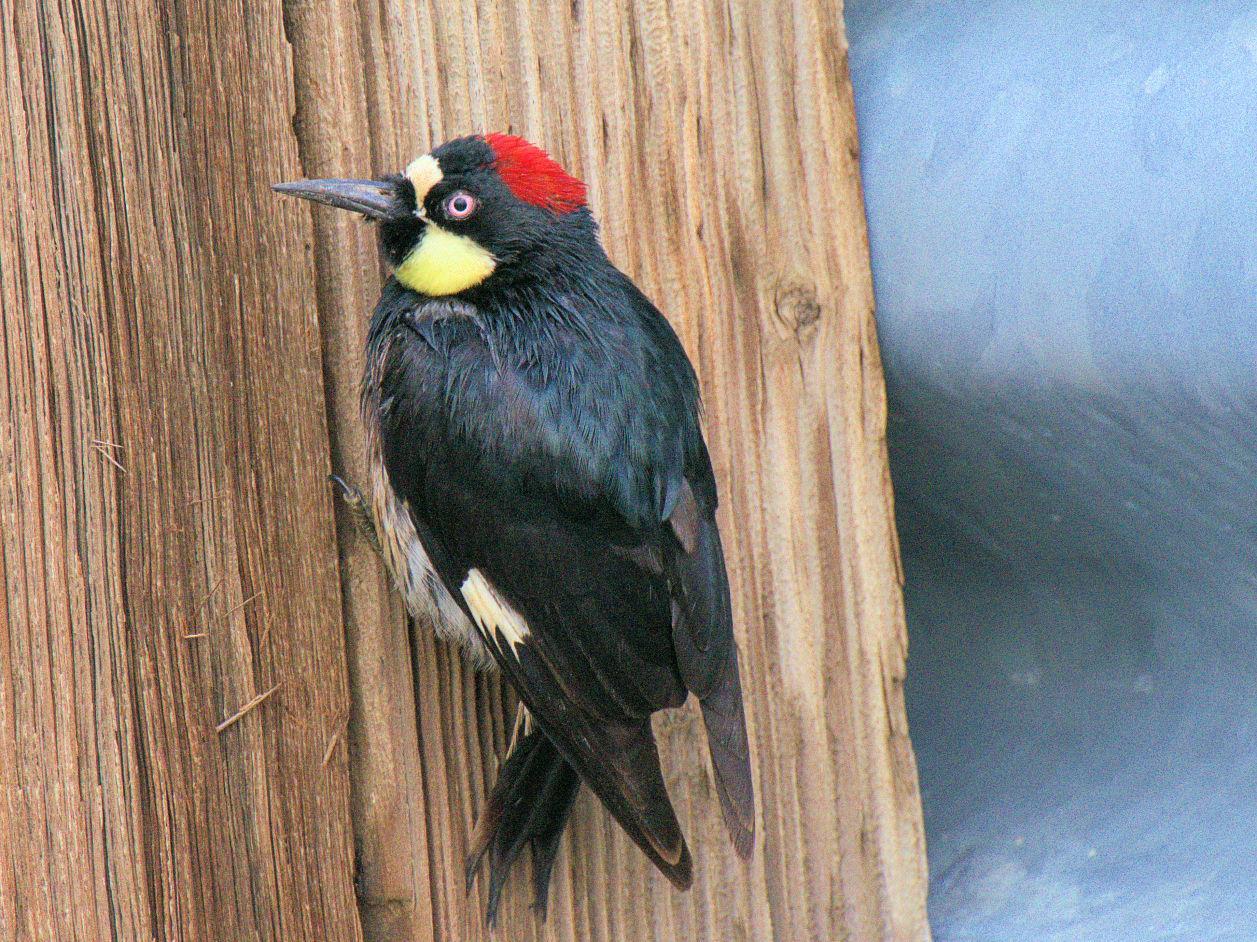
Voice: Their most common sound is a loud raucous laughing. Being highly social, they are very vocal. A noisy and bothersome acorn woodpecker pounding on the wall of a mountain cabin at June Lake in the Sierra Nevada was the inspiration for Walter Lantz’s Woody Woodpecker cartoon character. Lantz’s wife, Grace Stafford, suggested the idea and later became the voice of Woody. The appearance of Woody is more like that of the pileated woodpecker. Woody’s laugh represents much artistic license.
Other notes: This species requires mature oak trees and likes other large trees (and utility poles) as well. They are probably not threatened in the vicinity of PMC. They can become a problem for wooden structures. We have used plastic netting to discourage them from using our garage and house as granaries. So far, it has been successful. The netting has to be draped far enough off of the wood to keep them away. This species is probably not a regular propagator of oaks. They are too efficient.

